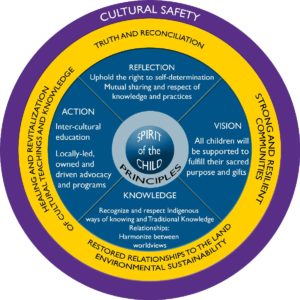At Save the Children, we want a world in which every child attains the right to survival, protection, development, and participation. How we interpret and translate this vision into our Reconciliation Program is a reconciled Canada – a nation of equity, respect and partnership, where every child attains the right to survive, protection, development, and participation.
As an organization, our mission is to inspire breakthroughs in the way the world treats children and to achieve immediate and lasting change in their lives. How we absorb this mission into our Reconciliation Program is by inspiring breakthroughs in the way Canada treats all children, especially First Nations, Métis and Inuit children, and to achieve both immediate and lasting change in their lives.
Our vision for reconciliation is centred on:
- Realizing the rights of First Nations, Métis and Inuit children, their families and communities
- Learning and capacity building for our staff members and leadership, including board members from the broader First Nation, Métis, and Inuit communities. This enables staff and leadership to develop a more meaningful understanding of First Nation, Métis, and Inuit Indigenous cultures and histories. Allowing them to build meaningful relationships with First Nation, Métis, and Inuit colleagues and beneficiaries
- Engaging in partnerships and collaborations with First Nations, Métis, and Inuit organizations, and communities to bring meaningful, tangible and sustainable contributions to our National Reconciliation Program through a child-centred approach.

Our approach is anchored by our Wi-Mino-Kisikat Relationship Framework which has been developed with Indigenous advisors to exemplify the principles of cultural safety needed to foster meaningful relationships with First Nations, Métis and Inuit partners.
Bringing meaningful, tangible, and sustainable results to reconciliation through a child-centred approach means:
Meaningful:
- Being child/youth and/or community-led, involving participation
- Being Rights-based (Convention on the Rights of the Child, UN Declaration of the Rights of Indigenous Peoples)
- Being Culturally informed, strength-based and gender responsive; and
- Leveraging the unsurpassed local knowledge offered by our First Nations, Métis and Inuit partners.
Tangible:
- Being evidence-based and evidence producing
- Being effective in monitoring and evaluation
- Adhering to the standards and principles of Indigenous collective and self-determined data management and governance
- Actioning the Truth and Reconciliation Calls to Actions.
- Actioning the Sustainable Development Goals
Sustainable:
- Engaging in mutual learning, capacity building, and empowerment
- Engaging in long-term partnerships
- Ensuring First Nations, Métis, and Inuit partners are central to the design and delivery of the program
- Handing over programs to our partners to deliver it themselves when they express they are ready
We understand that reconciliation is a continuous and evolving process. We are firmly committed to bringing our vision to life at every level of our organization and through every aspect of our programs, policy work and related operations.
We recognize and value the diversity of First Nations, Métis and Inuit peoples, and cultures, and we strive to work authentically with children, their families and communities to ensure that our programs are meaningful, tangible, and are sustainable. By supporting our National Reconciliation Program, it enables us to work in partnership with First Nations, Métis, and Inuit children and communities to bring meaningful, tangible, sustainable results to reconciliation through a child-centred approach.


